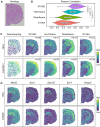High-density generation of spatial transcriptomics with STAGE
- PMID: 38647109
- PMCID: PMC11109953
- DOI: 10.1093/nar/gkae294
High-density generation of spatial transcriptomics with STAGE
Abstract
Spatial transcriptome technologies have enabled the measurement of gene expression while maintaining spatial location information for deciphering the spatial heterogeneity of biological tissues. However, they were heavily limited by the sparse spatial resolution and low data quality. To this end, we develop a spatial location-supervised auto-encoder generator STAGE for generating high-density spatial transcriptomics (ST). STAGE takes advantage of the customized supervised auto-encoder to learn continuous patterns of gene expression in space and generate high-resolution expressions for given spatial coordinates. STAGE can improve the low quality of spatial transcriptome data and smooth the generated manifold of gene expression through the de-noising function on the latent codes of the auto-encoder. Applications to four ST datasets, STAGE has shown better recovery performance for down-sampled data than existing methods, revealed significant tissue structure specificity, and enabled robust identification of spatially informative genes and patterns. In addition, STAGE can be extended to three-dimensional (3D) stacked ST data for generating gene expression at any position between consecutive sections for shaping high-density 3D ST configuration.
© The Author(s) 2024. Published by Oxford University Press on behalf of Nucleic Acids Research.
Figures







References
-
- Asp M., Giacomello S., Larsson L., Wu C., Fürth D., Qian X., Wärdell E., Custodio J., Reimegård J., Salmén F. et al. . A spatiotemporal organ-wide gene expression and cell atlas of the developing human heart. Cell. 2019; 179:1647–1660. - PubMed
-
- Chen W.-T., Lu A., Craessaerts K., Pavie B., Sala Frigerio C., Corthout N., Qian X., Laláková J., Kühnemund M., Voytyuk I. et al. . Spatial transcriptomics and in situ sequencing to study Alzheimer's disease. Cell. 2020; 182:976–991. - PubMed
MeSH terms
Grants and funding
- 2021YFA1302500/National Key Research and Development Program of China
- 32341013/National Natural Science Foundation of China
- 2020B1111190001/Key-Area Research and Development of Guangdong Province
- 2023K0602/R&D Project of Pazhou Lab (Huangpu)
- YSBR-034/CAS Project for Young Scientists in Basic Research
LinkOut - more resources
Full Text Sources

